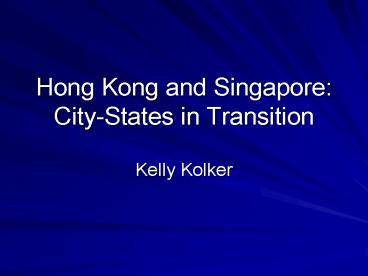Hong Kong and Singapore: CityStates in Transition - PowerPoint PPT Presentation
1 / 16
Title:
Hong Kong and Singapore: CityStates in Transition
Description:
Laissez Faire non Interventionist. Developed manufacturing sector ... Result: Still interventionist. Hong Kong: Positive Non-Interventionism ... – PowerPoint PPT presentation
Number of Views:89
Avg rating:3.0/5.0
Title: Hong Kong and Singapore: CityStates in Transition
1
Hong Kong and Singapore City-States in Transition
- Kelly Kolker
2
Similarities
- Externally oriented industrialization
- No contention with rural-based elites
- Free operation of labor markets
- Government STRONG and independent executives
Weak subordinate legislatures.
3
Differences
- SINGAPORE
- Economic Policy Interventionist
- Foreign Investment
- Weak domestic private sector
- Peoples Action Party (PAP) social conflicts
- HONG KONG
- Laissez-Faire
- Local Firms
- Large entrepreneurial capability in domestic
sector - No one contested political authority Power in
Financial Secretariat
4
Singapore
- Industrialization
- Manufacturing Industries Tin Rubber Weak
- Peoples Action Party 1959) Control Structure
under Lee Kuan Yew - Independence from Malaysia Shift from ISI to,
Export Oriented system - The government used an external crisis to impose
both a new dev. Strategy and a new level of labor
discipline. (113)
5
State Institutions Economy
- Economic Development Board (EDB)
- Desirable Industries
- adversely affect other industries
- fill a gap in the industrial structure
- generate linkages with other industries
- Investment Promotion Division (IPD)
- Attract foreign investment
6
Hong Kong
- Industrialization
- Laissez Faire non Interventionist
- Developed manufacturing sector
- Developed commercial and banking establishments
- Political Structure Similar to EA Pattern
- External Shocks Chinese Revolution and UN
Embargo on trade with China
7
Political and Institutional Foundations of
Laissez Faire
- Macro-level no trade restrictions, no central
bank - Micro-level Industry not a function of
government loans, subsidies or protection - No distinction between local and foreign firms
- Government LAND, water, postal system, and
airport services.
8
The Second Industrial Revolution 1979
- Singapore Upgrading its exports
- Control of labor
- Ten Year Economic Development Plan
- Goal increase the share of the manufacturing
sector in GNP - Second Industrial Revolution confirmed dominance
of multi-nationals
9
2nd Generation of PAP and Downturn
- Technocrats Little if any political experience
bureaucracy, academia, private sector - Downturn short-term factors and governments
management of economy balance of power between
the public sector and foreign and local firms. - Over 100 state-owned enterprises that competed
directly with the private sector - Result Still interventionist
10
Hong Kong Positive Non-Interventionism
- State Intervention 4 areas
- Control of monetary policy and the foreign
exchange markets - Regulation of the Financial Sector
- Extending basic social services education,
medical services, public housing - Sponsor industrial and economic advisory boards
to maintain a dialog with the private sector over
economic policy
11
Hong Kong Financial Center
- Contributing Factors
- Location rapid economic development of the
region - Demand for an international financial center in
an East Asian Time Zone
12
Political Environment
- Sino-British Agreement 1984 Guaranteed the
continuity of the capitalist system for half a
century after sovereignty had been reverted to
China in 1997. (154) - Created a Crisis of Confidence
- HK dollar pegged to US dollar
- Growing relations with China
- Joint Declaration
13
Singapore v. Hong Kong
- Importance of domestic structures and ideologies
in shaping national responses to external
pressures - Singapore aggressive toward industrial
adjustment - Hong Kong Maintained a non-interventionist policy
14
Political Liberalization
- Domestic Pressures
- Members of the bureaucracy who believe in
government activism - Private Sector Support v. Unnecessary
Direction - Speed and direction of adjustment will be
affected expanding scope and level of political
participation
15
What Next?
- Emergence of an attentive middle-classs
- Increasing organizational capacities of societal
actors more players, more demands on the state - Haggard Greater politicization will reduce the
coherence of policy and the speed with which
adjustments can be undertaken. (160)
16
Question/Discussion
- Proposition Successful export-led growth demands
state-intervention? True or False? - What was the fundamental reason for Singapores
downturn in the 1980s? - Liberalizing Reforms Good Idea or Bad?
- Greater political opportunities to oppositions
over the long run, or will it serve as a
deterrent to the coherence of policy and the
speed with which adjustments can be undertaken?
What does Haggard think?































